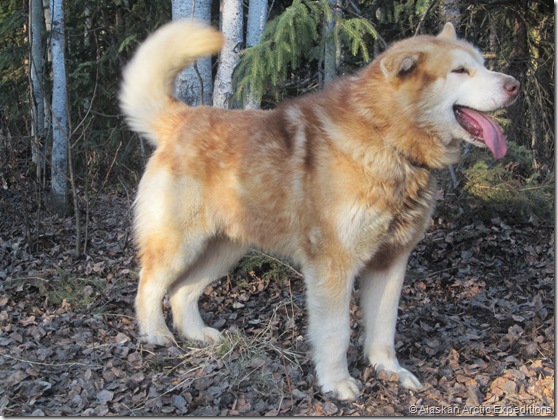May 13, 2012
The Pulling Factor II—The Early Years
Per a request on Facebook, I’m going to elaborate on the highlights of my training methods for my malamutes.
There are many strains of Alaskan malamutes around the world. Some are light weight, small-boned, and swift running dogs; others are heavy, large-boned and slower paced animals. There isn’t a “one size fits all” malamute. Although the AKC has their standards, and Mother Nature has hers, we won’t get into that. In this post, I am addressing the larger freighting malamute strain which I use in the Arctic. I hope everyone can find a nugget or two of information that they find helpful in training their own working dog or pet.

In my previous post I mentioned tapping into a dog’s psyche. Training dogs to pull/work with 100% effort is 100% psychological training. For a number of reasons, I prefer not to start officially training my malamutes to pull until they’re 2 years of age. The larger malamutes tend to mature very slowly, both physically and mentally, sometimes not until 3 or 4 years of age.
Prior to age 2, the puppy lives a carefree life. I don’t implement any pulling training whatsoever. In fact the 2 year old isn’t even put into a harness until his first run in a team, and that run is only 5 to 10 minutes long—just enough to give him a sweet taste of what he was born to do. It’s like planting a seed in fertile ground, and watering it lightly until the seed blooms into a full-fledged plant. After the pup’s first run, I won’t run him for a few more days so his subconscious has time to mull over the fun he experienced for those 5 to10 minutes and he’s ready and craving for more.
Larger malamutes tend to desire hard, slower paced pulls rather than fast runs, which actually can cause injury or, at the least, soreness that can sour his attitude toward working. This can be devastating since pups at this age are very impressionable. So I always load the sled with a substantial amount of weight and allow him to pull to his heart’s content. I don’t overdo it with the weight, but I put in just enough so the speed isn’t faster than his natural ability.
After the pup eases into longer training runs, he becomes stronger and more confident with his ability to pull and keep up with his veteran teammates. At this point in his training the pup has never experienced fatigue or any type of strenuous pull wherein he loses his confidence. All he has experienced is when he pulls the sled moves and he’s doing what he was born to do. He pulls with all his might because he wants to and he learns commands from following the example of the older dogs in the team. The pup will observe and learn that, for example, when he hears the command to stop, the team halts. It won’t take him long to get it figured out.
When the going gets tough, say if the team comes to a steep hill and they’re breaking trail with a lot of weight in the sled, the rookie doesn’t stop because he hasn’t heard the command so he continues pulling with his young passion which is growing stronger by the day. However, on a swift trail with a light load, he notices and follows his teammates’ example and “holds back,” conserving energy. This is a natural instinct, to conserve energy to avoid exhaustion. But he knows when the going gets tough, the tough get going, and being that malamutes are naturally go-getters, that is the part he loves most.

So, to summarize my training philosophy, I look at it like this…
All of God’s creatures have physical and psychological limitations, although if malamutes/working dogs believe their strength is invincible because they haven’t been introduced to the dark beast called “limit” they will work with passion for their entire lives. If a person nurses and builds up their egos, never allowing them to recognize that their muscles, bones and tendons are due to fail at a certain point, in their mind’s eye, they can’t be beat and there is no limit to their strength.
Joe

